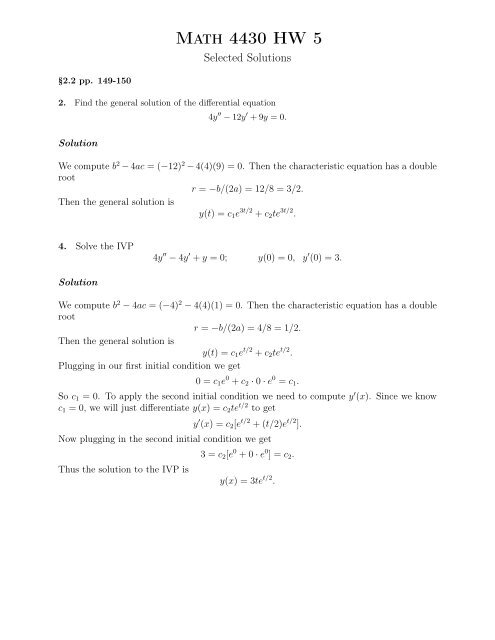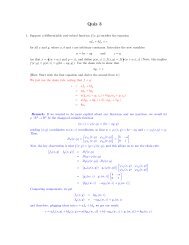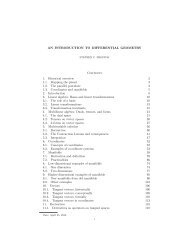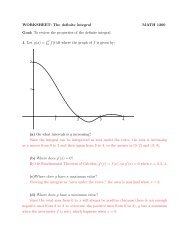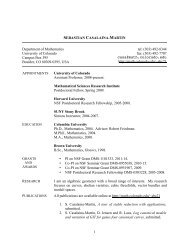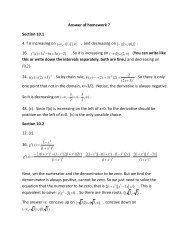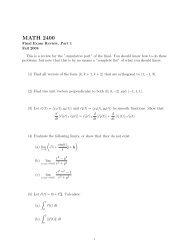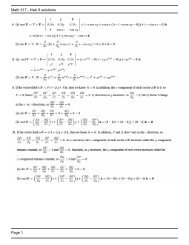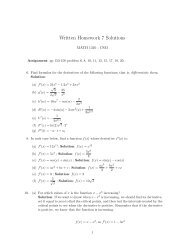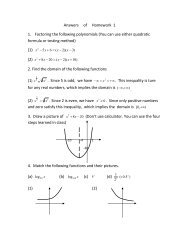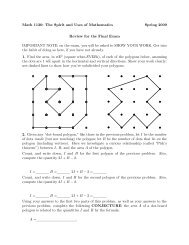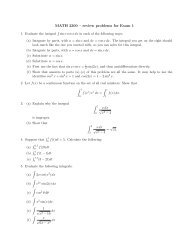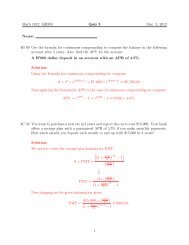HW 5 solutions
HW 5 solutions
HW 5 solutions
Create successful ePaper yourself
Turn your PDF publications into a flip-book with our unique Google optimized e-Paper software.
§2.2 pp. 149-150<br />
Math 4430 <strong>HW</strong> 5<br />
Selected Solutions<br />
2. Find the general solution of the differential equation<br />
Solution<br />
4y ′′ − 12y ′ + 9y = 0.<br />
We compute b 2 − 4ac = (−12) 2 − 4(4)(9) = 0. Then the characteristic equation has a double<br />
root<br />
r = −b/(2a) = 12/8 = 3/2.<br />
Then the general solution is<br />
y(t) = c1e 3t/2 + c2te 3t/2 .<br />
4. Solve the IVP<br />
Solution<br />
4y ′′ − 4y ′ + y = 0; y(0) = 0, y ′ (0) = 3.<br />
We compute b 2 − 4ac = (−4) 2 − 4(4)(1) = 0. Then the characteristic equation has a double<br />
root<br />
r = −b/(2a) = 4/8 = 1/2.<br />
Then the general solution is<br />
y(t) = c1e t/2 + c2te t/2 .<br />
Plugging in our first initial condition we get<br />
0 = c1e 0 + c2 · 0 · e 0 = c1.<br />
So c1 = 0. To apply the second initial condition we need to compute y ′ (x). Since we know<br />
c1 = 0, we will just differentiate y(x) = c2te t/2 to get<br />
y ′ (x) = c2[e t/2 + (t/2)e t/2 ].<br />
Now plugging in the second initial condition we get<br />
Thus the solution to the IVP is<br />
3 = c2[e 0 + 0 · e 0 ] = c2.<br />
y(x) = 3te t/2 .
§2.3 pp. 152-153<br />
2. Three <strong>solutions</strong> of a certain second-order linear nonhomogeneous equation are<br />
ψ1(t) = 1 + e t2<br />
ψ2(t) = 1 + te t2<br />
ψ2(t) = (t + 1)e t2<br />
+ 1.<br />
Find the general solution to this equation.<br />
Solution<br />
We know that the general solution is of the form<br />
y(x) = ψ + c1y1 + c2y2<br />
where ψ is any solution to the nonhomogeneous equation (so we could take any of the<br />
above <strong>solutions</strong> to be ψ) and where y1 and y2 are two linearly independent <strong>solutions</strong> to the<br />
homogeneous equation.<br />
We know that the difference between any two <strong>solutions</strong> of the nonhomogeneous equation is<br />
a solution to the homogeneous equation, so we may take<br />
and<br />
y1 = ψ3 − ψ2 = e t2<br />
y2 = ψ3 − ψ1 = te t2<br />
are both <strong>solutions</strong> to the homogeneous equation. Clearly y1 and y2 are not constant multiples<br />
of each other, so they are linearly independent. Taking ψ = ψ1, we get the general solution<br />
or more simply<br />
y(x) = 1 + e t2<br />
+ c1e t2<br />
+ c2te t2<br />
y(x) = 1 + c1e t2<br />
+ c2te t2<br />
.
§2.4 pp. 156-157<br />
2. Find the general solution of the equation<br />
Solution In the homogeneous equation<br />
y ′′ − 4y ′ + 4y = te 2t .<br />
y ′′ − 4y ′ + 4y = 0<br />
we have b 2 − 4ac = (−4) 2 − 4(1)(4) = 0 so the characteristic equation has the double root<br />
r = −b/(2a) = 4/2 = 2.<br />
Then the general solution to the homogeneous equation is c1y1 + c2y2 where we have<br />
and<br />
y1 = e 2t<br />
y2 = te 2t .<br />
By the variation of parameters method, there is a particular solution of the form<br />
ψ = u1y1 + u2y2<br />
Since there formulas for u1 and u2 involve the Wronskian, we compute<br />
W [y1, y2] = e 2t (e 2t + 2te 2t ) − 2e 2t (te 2t ) = e 4t<br />
Now we apply the formulas for u1 and u2 to get<br />
and also<br />
Then we have the particular solution<br />
<br />
−gy2<br />
W dt<br />
2t 2t −(te )te<br />
=<br />
e4t dt<br />
<br />
= −t 2 dt<br />
u1 =<br />
= −t 3 /3<br />
<br />
gy1<br />
W dt<br />
2t 2t (te )e<br />
=<br />
e4t dt<br />
<br />
= t dt<br />
u2 =<br />
= t 2 /2<br />
ψ = −t 3 /3 e 2t + t 2 /2 te 2t = 1<br />
6 t3 e 2t<br />
so the general solution to the nonhomogeneous equation is<br />
y(x) = 1<br />
6 t3 e 2t + c1e 2t + c2te 2t .
9. Find two linearly independent <strong>solutions</strong> of<br />
t 2 y ′′ − 2y = 0<br />
of the form y = t r and using these find the general solution of<br />
t 2 y ′′ − 2y = t 2 .<br />
Solution The nonhomogeneous equation above is Euler’s equation (see problem 10 on pg<br />
140 from hw 4) since it is of the form<br />
t 2 y ′′ + αty ′ + βy = 0<br />
where we have α = 0 and β = −2 in this case. In problem 10 you showed that y = t r would<br />
be a solution if r was a root of<br />
so in this case we must find the roots of<br />
r 2 + (α − 1)r + β = 0<br />
r 2 − r − 2 = 0<br />
which are r1 = −1 and r2 = 2. Thus we have <strong>solutions</strong><br />
y1 = 1<br />
t<br />
and<br />
y2 = t 2<br />
which are clearly linearly independent. A particular solution is given by<br />
ψ = u1y1 + u2y2<br />
and to find u1 and u2 we will need to compute the Wronskian:<br />
W [y1, y2] = 1 −1<br />
(2t) −<br />
t t2 t2 = 3.<br />
We also need to know the RHS g(t), and here it is important to first put our equation in the<br />
form<br />
y ′′ + py ′ + qy = g(t)<br />
so after doing so we in fact see that g(t) = 1. Then applying the formulas for u1 and u2 we<br />
get<br />
2<br />
−gy2 −t<br />
u1 = dt =<br />
W 3 dt = −t3 /9<br />
and also<br />
<br />
gy1<br />
u2 = dt = 1/(3t) dt = (1/3) ln |t|.<br />
W<br />
Then we have the particular solution<br />
ψ = (−t 3 /9)(1/t) + (1/3)(ln |t|)(t 2 ) = −t2<br />
9 + t2 ln |t|<br />
.<br />
3<br />
Then the general solution to the nonhomogeneous equation is<br />
or more simply<br />
y(x) = −t2<br />
9 + t2 ln |t| c1 2<br />
+ + c2t<br />
3 t<br />
y(x) = t2 ln |t|<br />
3<br />
+ c1<br />
t + c2t 2 .


